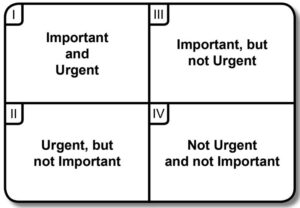An excellent and easy way to decide on priorities is Stephen R. Covey’s Time Management Quadrant. I’ve been using this to create clarity in my todo’s for ages, which has completely changed my view on my work.
How To Set Priorities – Stephen Covey’s Time Management Grid Revealed
The previous four articles in this eight-part series respectively covered the causes of procrastination, how to overcome procrastination, the Ultimate Way to increase productivity and 10 ways to improve productivity. This week another important part of time management: setting priorities.
What often goes wrong in our work is that we allow unimportant tasks to precede more essential things. Because they’re faster, easier, more urgent. That way, we end up in a rut of endless operational tasks that never allows us the time to work on those dream projects of ours. What to do?
We run around saying: ‘If only I had more time, I could get everything done.’ The good news is: you do! The bad news: you’ll have to let some things go. If you don’t, more time would just give you more meaningless tasks to fill it up with. What you need is to stay conscient of and focused on what’s really important. That’s the only way to get the big things done in life!
Part 5/8: How To Set Priorities – Covey’s Time Management Grid
I used to be stressed all the time and complain about not being able to do what I wanted; now I just decide what I want to do and make time for it.
So let’s get to it! Look at the quadrant below and put it on a big piece of paper, but keep the squares empty. Now what are these quadrants all about?

Things in Sector I are both Urgent and Important. These are most often things that come from others: deadlines for clients, reports for you manager… Things that need to be done yesterday, or things will blow up. Sector II contains things that are important, but not urgent. It’s our real goals, the things we want to realize in life. Sadly, it’s also the things that we delay because of things in Sector I – or worse, in Sector III: things that are urgent but not important at all.
A good planning creates a balance between sectors I and II. Ideally, you should clear out Sector I completely and work only in Sector II. As for Sectors III en IV: it may sound harsh, but I think it’s best you let them go. Especially as long as there are still things to do in Sector I or II.
How to decide what’s important (or not)
If you find you have nothing to put in Sector III and IV, you’re probably taking on too much. Choose what you really want to get done, and what you could live without. Let them go for the time being. Focus on those things that are essential to you, and forget about all the rest. Result: more focus, less clutter!
Assignment: fill in all of your work, projects, dreams… in these quadrants. Take a look at your planning and work: are they in concordance with your priorities? If not, adapt your planning!
The next three articles in this series will deal with Email Time Management and getting things done when working from home.
Don’t forget to check out the previous articles in this series: